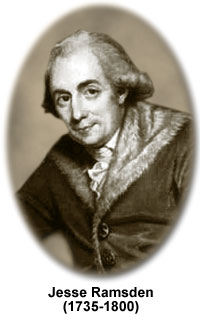Jesse Ramsden
(1735-1800)

Jesse Ramsden was an eighteenth century English designer and manufacturer of mathematical and astronomical instruments. He is best known for the design of a telescope and microscope eyepiece (ocular) that bears his name and is still commonly used today.
Born in Yorkshire, England, on October 6, 1735, Ramsden was the son of an innkeeper. As a young boy, Ramsden was apprenticed to a cloth worker, but in the long run, the textile industry did not interest him. At the age of 23 he apprenticed himself to a mathematical instrument maker and, in a very short time, Ramsden demonstrated that he was a brilliant and skillful designer of instruments. In just four years, he started his own business in London. Ramsden soon became acknowledged as the best designer and manufacturer of mathematical, astronomical, surveying and navigational instruments in England.
Ramsden designed instruments of great accuracy, largely due to his invention of the dividing engine. Prior to his creation of the device, the division and inscription of scales on mathematical instruments was done by hand, but Ramsden's divider eliminated the risk of human error and made it feasible to inscribe lines accurate to a second of an arc. Due to the precision he could obtain, Ramsden's instruments were in great demand and he furnished achromatic telescopes equipped with accurately divided circles to many European observatories. Insisting on only the highest quality was problematic at times, however, since Ramsden had a reputation for completing the orders of his customers belatedly.
Ramsden made significant improvements to the design of theodolites and transits, as well as invented a pyrometer to quantify thermal expansion and a device for determining telescopic powers. Yet, he is most remembered for designing a unique eyepiece for reflecting telescopes. The Ramsden eyepiece reduces blurring of the image caused by chromatic aberrations and is still used in telescopes.
In addition to his other endeavors, Ramsden, who was intrigued by electricity, built and designed one of the first electrostatic generators. The electricity produced by Ramsden generators was sometimes used in medical treatments of the day, especially in cases of paralysis, muscle spasms, and heart problems. The machines were also utilized to charge Leyden jars, which are capacitors that can be used to store electrical charge by touching their tops to a generator.
Recognized for his various achievements, Ramsden was elected to the Royal Society in 1786 and awarded the Copley Medal in 1795. He has also been memorialized for his contribution to astronomy by having a crater on the moon named in his honor.
